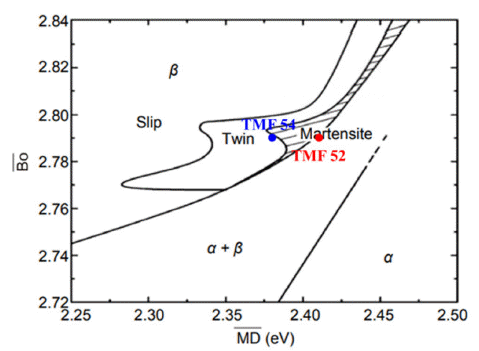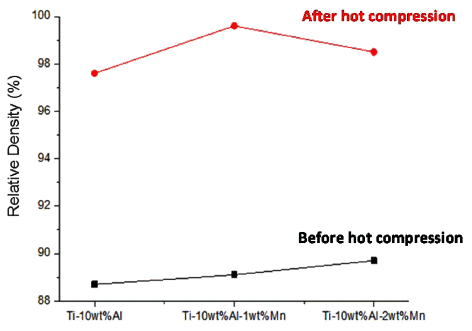Search
- Page Path
- HOME > Search
- [Korean]
- Effect of Iron Content on Microstructure and Mechanical Properties of Ti-Mo-Fe P/M Alloys
- HyoWoon Hwang, YongJae Lee, JiHwan Park, Dong-Geun Lee
- J Powder Mater. 2022;29(4):325-331. Published online August 1, 2022
- DOI: https://doi.org/10.4150/KPMI.2022.29.4.325

- 838 View
- 6 Download
- 2 Citations
-
 Abstract
Abstract
 PDF
PDF Beta-titanium alloys are used in many industries due to their increased elongation resulting from their BCC structure and low modulus of elasticity. However, there are many limitations to their use due to the high cost of betastabilizer elements. In this study, biocompatible Ti-Mo-Fe beta titanium alloys are designed by replacing costly betastabilizer elements (e.g., Nb, Zr, or Ta) with inexpensive Mo and Fe elements. Additionally, Ti-Mo-Fe alloys designed with different Fe contents are fabricated using powder metallurgy. Fe is a strong, biocompatible beta-stabilizer element and a low-cost alloying element. The mechanical properties of the Ti-Mo-Fe metastable beta titanium alloys are analyzed in relation to the microstructural changes. When the Fe content increases, the tensile strength and elongation decrease due to brittle fracture despite a decreasing pore fraction. It is confirmed that the hardness and tensile strength of Ti-5Mo-2Fe P/M improve to more than 360 Hv and 900 MPa, respectively.
-
Citations
Citations to this article as recorded by- Fabrication of Ti-Mo Core-shell Powder and Sintering Properties for Application as a Sputtering Target
Won Hee Lee, Chun Woong Park, Heeyeon Kim, Yuncheol Ha, Jongmin Byun, Young Do Kim
journal of Korean Powder Metallurgy Institute.2024; 31(1): 43. CrossRef - Effect of Strain Rate on Deformation Behaviors of Ti-12.1Mo -1Fe Metastable Beta Alloy
In Kyeong Jin, Dong-Geun Lee
Korean Journal of Metals and Materials.2023; 61(10): 741. CrossRef
- Fabrication of Ti-Mo Core-shell Powder and Sintering Properties for Application as a Sputtering Target
- [Korean]
- Effect of post heat treatment on fatigue properties of EBM 3D-printed Ti-6Al-4V alloy
- Young-Sin Choi, Ji-Hoon Jang, Gun-Hee Kim, Chang-Woo Lee, Hwi-Jun Kim, Dong-Geun Lee
- J Korean Powder Metall Inst. 2018;25(4):340-345. Published online August 1, 2018
- DOI: https://doi.org/10.4150/KPMI.2018.25.4.340

- 769 View
- 8 Download
- 4 Citations
-
 Abstract
Abstract
 PDF
PDF Additive manufacturing by electron beam melting is an affordable process for fabricating near net shaped parts of titanium and its alloys. 3D additive-manufactured parts have various kinds of voids, lack of fusion, etc., and they may affect crack initiation and propagation. Post process is necessary to eliminate or minimize these defects. Hot isostatic pressing (HIP) is the main method, which is expensive. The objective of this paper is to achieve an optimum and simple post heat treatment process without the HIP process. Various post heat treatments are conducted for the 3Dprinted Ti-6Al-4V specimen below and above the beta transus temperature (996°C). The as-fabricated EBM Ti-6Al-4V alloy has an α‘-martensite structure and transforms into the α+β duplex phase during the post heat treatment. The fatigue strength of the as-fabricated specimen is 400 MPa. The post heat treatment at 1000°C/30 min/AC increases the fatigue strength to 420 MPa. By post heat treatment, the interior pore size and the pore volume fraction are reduced and this can increase the fatigue limit.
-
Citations
Citations to this article as recorded by- Effect of Line Energy Conditions on Mechanical and Fatigue Properties of Ti6Al4V Fabricated by Electron Beam Additive Manufacturing
Youngsin Choi, Hwi-Jun Kim, Gun-Hee Kim, Chang-Woo Lee, Dong-Geun Lee
Metals.2021; 11(6): 878. CrossRef - Mechanical and Physical Characteristics Analysis of Radius Trauma Plate by EBM Additive Manufacturing
Kwun-Mook Lim, Sung-Jun Park
Journal of the Korean Society of Manufacturing Technology Engineers.2020; 29(2): 147. CrossRef - Effect of Heat Treatments on Fatigue Properties of Ti-6Al-4V Alloy Fabricated by EBM Additive Manufacturing
Dong-Geun Lee, Youngsin Choi, P. Villechaise, B. Appolaire, P. Castany, M. Dehmas, C. Delaunay, J. Delfosse, A. Denquin, E. Gautier, L. Germain, N. Gey, T. Gloriant, J.-Y. Hascoët, S. Hémery, Y. Millet, D. Monceau, F. Pettinari-Sturmel, M. Piellard, F. Pr
MATEC Web of Conferences.2020; 321: 03027. CrossRef - Correlation between surface tension and fatigue properties of Ti-6Al-4V alloy fabricated by EBM additive manufacturing
Youngsin Choi, Dong-Geun Lee
Applied Surface Science.2019; 481: 741. CrossRef
- Effect of Line Energy Conditions on Mechanical and Fatigue Properties of Ti6Al4V Fabricated by Electron Beam Additive Manufacturing
- [Korean]
- Effect of Mn Addition on Sintering Properties of Ti-10wt.%Al-xMn Powder Alloy
- Gi-Seung Shin, Yong-Taek Hyun, Nho-Kwang Park, Yong-Ho Park, Dong-Geun Lee
- J Korean Powder Metall Inst. 2016;24(3):235-241. Published online June 1, 2016
- DOI: https://doi.org/10.4150/KPMI.2017.24.3.235

- 582 View
- 2 Download
- 2 Citations
-
 Abstract
Abstract
 PDF
PDF Titanium alloys have high specific strength, excellent corrosion and wear resistance, as well as high heatresistant strength compared to conventional steel materials. As intermetallic compounds based on Ti, TiAl alloys are becoming increasingly popular in the aerospace field because these alloys have low density and high creep properties. In spite of those advantages, the low ductility at room temperature and difficult machining performance of TiAl and Ti3Al materials has limited their potential applications. Titanium powder can be used in such cases for weight and cost reduction. Herein, pre-forms of Ti-Al-xMn powder alloys are fabricated by compression forming. In this process, Ti powder is added to Al and Mn powders and compressed, and the resulting mixture is subjected to various sintering temperature and holding times. The density of the powder-sintered specimens is measured and evaluated by correlation with phase formation, Mn addition, Kirkendall void, etc. Strong Al-Mn reactions can restrain Kirkendall void formation in Ti-Al-xMn powder alloys and result in increased density of the powder alloys. The effect of Al-Mn reactions and microstructural changes as well as Mn addition on the high-temperature compression properties are also analyzed for the Ti-Al-xMn powder alloys.
-
Citations
Citations to this article as recorded by- Lattice Deformation and Improvement Oxidation Resistance of Ti-6Al-4V Alloy Powders Prepared by Hydrogen Added Argon Heat Treatment
Gye-Hoon Cho, Jung-Min Oh, Jae-Won Lim
Journal of Korean Powder Metallurgy Institute.2019; 26(2): 126. CrossRef - Effect of post heat treatment on fatigue properties of EBM 3D-printed Ti-6Al-4V alloy
Young-Sin Choi, Ji-Hoon Jang, Gun-Hee Kim, Chang-Woo Lee, Hwi-Jun Kim, Dong-Geun Lee
Journal of Korean Powder Metallurgy Institute.2018; 25(4): 340. CrossRef
- Lattice Deformation and Improvement Oxidation Resistance of Ti-6Al-4V Alloy Powders Prepared by Hydrogen Added Argon Heat Treatment
TOP
 kpmi
kpmi


 First
First Prev
Prev


